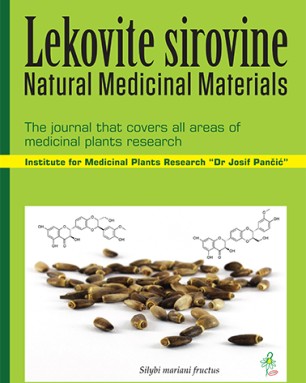Institute for Medicinal Plant Research “Dr. Josif Pančić” , Belgrade , Serbia
Institute for Medicinal Plant Research “Dr. Josif Pančić” , Belgrade , Serbia
Faculty of Agriculture, University of Belgrade , Belgrade , Serbia
Institute of Pesticides and Environmental Protection , Belgrade , Serbia
Faculty of Agriculture, University of Belgrade , Belgrade , Serbia
The evaluation of the inhibition effect achieved by essential oils of dill (Anethum graveolens L.), oregano (Origanum vulgare L.), juniper (Juniperus communis L.), sage (Salvia officinalis L.) and winter savory (Satureja montana L.) on seed germination and shoot growth of Johnson grass (Sorghum halepense L.) was tested in laboratory. The chemical composition of essential oils was analyzed by gas chromatography (GC) and gas chromatography-mass spectrometry (GC-MS). The major constituents were carvon (40.5%) and limonene (32.2%) for A. graveolens essential oil, carvacrol (73.7%) for O. vulgare essential oil, α-pinene (43.5%) for J. communis essential oil, b-thujone (32.7%) and camphor (17.2%) for S. officinalis essential oil, thymol (44.6%) and p-cimene (13.4%) for S. montana essential oil. The in vitro study on herbicidal activity was carried out on seed germination and shoots length of S. halepense; A. graveolens, O. vulgare, S. montana essential oils significantly inhibited the germination and shoot length and their herbicidal activity could be attributed mainly to their high content of carvone, carvacrol and thymol. A. graveolens, O. vulgare and S. montana essential oils reduced seed germination by 61.5%, 52.7% and 47.3%, respectively, while J. communis and S. officinalis essential oils stimulated germination (7.7% and 2.2%, respectively). The shoot growth reduction for almost all essential oils, except J. communis essential oil, was more than 30%. The solution of A. graveolens, O. vulgare and S. montana essential oils exhibited more powerful bio-herbicidal effect compared to J. communis and S. officinalis essential oils on the germination and shoot growth of S. halepense.
This is an open access article distributed under the Creative Commons Attribution License which permits unrestricted use, distribution, and reproduction in any medium, provided the original work is properly cited.

The statements, opinions and data contained in the journal are solely those of the individual authors and contributors and not of the publisher and the editor(s). We stay neutral with regard to jurisdictional claims in published maps and institutional affiliations.